EDMONTON — An online survey of Albertans who have reached out for help during the COVID-19 crisis suggests the pandemic is taking a toll on mental health, with increased signs of obsessive behaviour, stress and depression.
"We did not expect people to be experiencing this level of anxiety, depression or stress," said Vincent Agyapong, a professor of psychiatry at the University of Alberta and co-author of a newly published paper.
Agyapong's research has focused on the lingering mental-health effects of public traumas such as the Fort McMurray wildfire. He and his colleagues have been asked by provincial and private agencies to help design a public mental-health response to COVID-19.
The paper, published in Environmental Research and Public Health, is an attempt to assess those needs.
"We thought it would be useful to collect baseline data," Agyapong said.
In late March, the researchers contacted about 33,000 Albertans who subscribed to Text4Hope — a government initiative that sends out a daily supportive text message written by mental health professionals. They asked subscribers to complete a survey that contained standard measures of anxiety, depression and obsessive behaviour.
About 6,000 people responded.
The survey, funded by a group of Alberta charitable health foundations, found that about 60 per cent of respondents had become worried about dirt, germs and viruses since the COVID-19 outbreak. About 54 per cent had begun washing their hands "very often or in a special way" that could be considered a symptom of obsessive compulsive disorder.
Nearly 50 per cent were considered probable candidates for anxiety disorders and more than 40 per cent were likely to be clinically depressed. Almost 85 per cent of respondents reported moderate to high stress.
The results were consistent between men and women. Symptoms and anxiety levels tended to increase with age and education levels.
Agyapong is cautious about the results. The survey sample isn't representative of the Alberta population. And some level of stress and unusual behaviour is understandable when people are losing their jobs and seeing society shut down around them.
But something is going on, he said.
"It's not diagnostic, but it is indicative," said Agyapong. "It doesn't necessarily mean (the results) aren't representative of what's going on."
Although research suggests about one-quarter of the general population will show some obsessive compulsive symptoms at some point in life, the incidence of the actual condition is only about two per cent — much lower than the figure in Agyapong's survey.
Agyapong points out his findings are consistent with studies done in other countries such as China.
He said simple measures can help — even the daily reassurance provided by Text4Hope. Preliminary results suggest that in six weeks, anxiety levels in subscribers fell by 20 per cent.
"It may not work for everybody, but if you can get it to work for even half of those who are struggling, then it means that you don't need more (expensive) resources at a population level," Agyapong said.
This report by The Canadian Press was first published Sept. 26, 2020
Bob Weber, The Canadian Press




